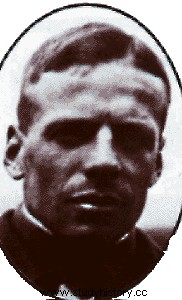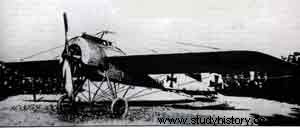Victory
21
Biography
Oswald Boelcke was one of the most famous German pilots of the Great War and the first fighter tactician

If we had to sum up oswald's personality in one word Boelcke, one of the first German pilots of the Great War, who defined the tactics of air combat, we would hardly be far from the truth by granting him the qualifier of "Father of the hunt". Not only did he formulate the theories of air combat, born of direct wartime experience, not only did he put them into practice himself, but he instilled them in the other young pilots who became aces of the First World War and transmitted in turn to their students.
Born May 19, 1891 in Giebichenstein, a small town near Halle (Saxony), Boelcke was the third boy in a family of six children. In March 1911, he chose a career in arms and joined the Prussian cadet corps, becoming an officer the following year. It was during military maneuvers that he had the opportunity to see airplanes for the first time and that he decided to become a pilot. Transferred at his request to the German Air Corps, he was to complete his pilot training a few days before the declaration of war, in August 1914.

Having had the opportunity to join his brother Wilhelm, then an observer in the Fliegerabteilung 13, in France, he carried out reconnaissance missions with him as a pilot and observer, which earned them both the Iron Cross (second and first class). Volunteers for all the missions, the two brothers achieved a total of outings higher than that of the other pilots of their squadron. The first fighters Towards the beginning of 1915, the first single-seat Fokker monoplanes arrived on the front lines and Boelcke immediately saw the possibilities they offered in combat. At this time of the war, the Fokkers were assigned sparingly to the Fliegerabteilungen to escort observation aircraft, but the intensification of air activity soon led to their use, armed with forward-firing machine guns, to the attack of French and British planes. Assigned in April to the FI. Abt. 62, Boelcke continued to fly on two-seater planes. It was with one of these that he won his first victory on July 4, shooting down (with his observer, the Leutnant Wuehlisch) a French observation device above Vouziers. Like Max Immelmann, a pilot in the same unit, Boelcke was soon entrusted with one of the new Fokkers. The two men soon made a name for themselves in Germany and even in France; Boelcke, in particular, earned a reputation among the French as a gentleman by saving a young boy from drowning (a letter and petition to Reich authorities earned him the German Lifesaving Medal).

On Fokker, Immelmann and Boelcke distinguished themselves from their first encounters with the British planes in the fall. But Boelcke was transferred to the French front as a bomber escort. He signed his sixth victory on January 6, 1916 and, a week later, received the famous Pour-le-Mérite cross. It was during his stay in France that he began to develop his hunting tactics. He studied the technical aspects of air combat - how to approach the adversary without being seen, how to choose the best angle of attack - and above all he quickly acquired the conviction that the effectiveness of combat aircraft would be increased if, instead of escorting groups of two-seaters in formations of two or three aircraft, they were used in formed units.

With nineteen victories, Boelcke was a national hero. His life being too precious to be exposed in combat. the German ace was retired from active service, and his proposal to organize single-seat fighters into formed fighter units was officially approved. Jasta 1 to 7 were created in August, and Boelcke took command of Jasta 2. He was free to choose his pilots and went on a selection tour of the Western and Eastern Fronts. Among those he chose were Erwin Boehme, Rudolf Reiman, Max Müller, Walter Hoehne, von Arnim and a promising young tandem pilot, Manfred von Richthofen. " Dicta Boelcke " Boelcke did his best to instruct his young comrades, very impatient to match the prowess of the national hero who shared with them his science of aerial combat. He formulated a set of rules which took the title of Dicta Boelcke and which still formed the basis of the principles of training for German fighter pilots during the Second World War, more than twenty years after their establishment.
These rules are as follows
- Always ensure an advantageous position before the attack. Climb before and during the approach in order to surprise the enemy from a higher altitude. Quickly sting on his rear when attacking.
- Always place yourself between the sun and the enemy, so that the latter, dazzled, is unable to shoot with precision.
- Do not shoot until the enemy is within range and perfectly framed by the sight.
- Attack when the enemy least expects it or when he is busy with other tasks such as observation, photography or bombardment.
- Never turn your back or run away from an enemy fighter. If you are surprised by an attack from the rear, turn and face with your weapons.
- Do not lose sight of the enemy and do not be fooled by his tricks. If the opponent seems hit, follow him to the ground to be sure of his destruction.
- Reckless acts of bravery only lead to death. The Jasta fights in groups and the missions are a team effort on the part of the pilots, who must absolutely obey the orders of the patrol leader. Unprecedented victories

It is at the controls of the new Albatros D-11 biplane that Boelcke began the practical part of the instruction, being the only one authorized, at the beginning, to fly near the front. On September 2, 1916, north of Thiepval, he won his twentieth personal victory, the first of the Jasta 2, in a single-seater De Havilland 2. Six days later, he shot down an FE.2b then, the next day, another DH .2, followed by a Sopwith 1 1/2 "Strutter" and a new DH.2 on the 14th. A day later he engaged some Strutter from 70 Squadron, whose leader, Captain G.L. shoot down the great Boelcke himself. In fact, following this engagement, it was Boelcke who claimed to have shot down two Sopwiths, including Cruickshank's.
On September 17, judging that his men were ready, the commander of Jasta 2 led them to attack a formation of BE.2c escorted by FE.2b. During the engagement, Boelcke destroyed an FE (twenty-seventh victory), while Richthofen, Boehme and er Reiman each took their first victory. Still at the head of his pilots, Boelcke shot down, on the 19th, a Morane and, a week later, a Martinsyde "Elephant".
The whole Jasta conducted itself brilliantly towards the end of September, it could claim twenty-one victories. Boelcke signed his thirtieth personal success on October 1st on a BE.2c, which was followed, on the 10th, by a Nieuport. Three days later, another important engagement brought four more victories to Jasta 2, with Boelcke, his good friend Boehme, Müller and Immelmann each awarding themselves an opponent. On October 16, Boelcke scored a brace with a BE and a DH.2, while Richthofen and Reiman each destroyed a BE. Between October 17 and 26, Boelcke shot down two more FEs, three BEs and a Strutter, bringing his personal tally to forty victories, a result which made him (at that date) the first German ace.
By October 20, Jasta 2 had claimed a total of fifty-one victories (including twenty-one credited to Boelcke), for the loss of only five pilots. The fatal collision On October 28, 1916, Oswald Boelcke led four patrols in the morning and a fifth in the afternoon. As night fell, Jasta 2 was ordered to take off again to engage a de Havilland British reconnaissance patrol that the Germans had discovered very close to the front. During the ensuing fight, the Albatross and escorting DHs engaged in a series of dogfights. Boelcke and Boehme were both swooping down on a De Havilland when another British aircraft, about to be attacked by Richthofen, cut them off. They attempted to get away from each other, but in the process, Boehme skidded over his captain's Albatross, and his landing gear ripped off part of the plane's upper plane. by Boelcke. This one went into a spin. His teammates, abandoning the English fighters, began to spiral around their leader, anxiously following the efforts he was trying to make to hold back his damaged plane. Pieces of wood and canvas continued to fall from the damaged wing as the spin accelerated, and it soon became apparent that the pilot had lost control of the aircraft. Just as Boelcke seemed to come out of the spin, the Albatross dived and crashed to the ground. The German ace died of a broken spine. He was twenty-five.
This death painfully struck the German people as all the air corps, which he had served so well to the point of being admired by his adversaries, who came above the field to throw a wreath of flowers in tribute to the pilot lost in action. A British pilot, prisoner in a camp in Germany, after being shot down by Oswald Boelcke, also sent a wreath. At Cambrai Cathedral, filled with a huge mourning crowd, where the funeral service took place, it was Manfred von Richthofen, the famous "Red Baron", who wore all the decorations of the ace killed on his forehead.
Jasta 2 - which had been renamed Jasta Boelcke in honor of the aviator who had been its prestigious leader - had become, by the end of the First World War, one of the units of the German Air Corps which had the largest number of victories.
